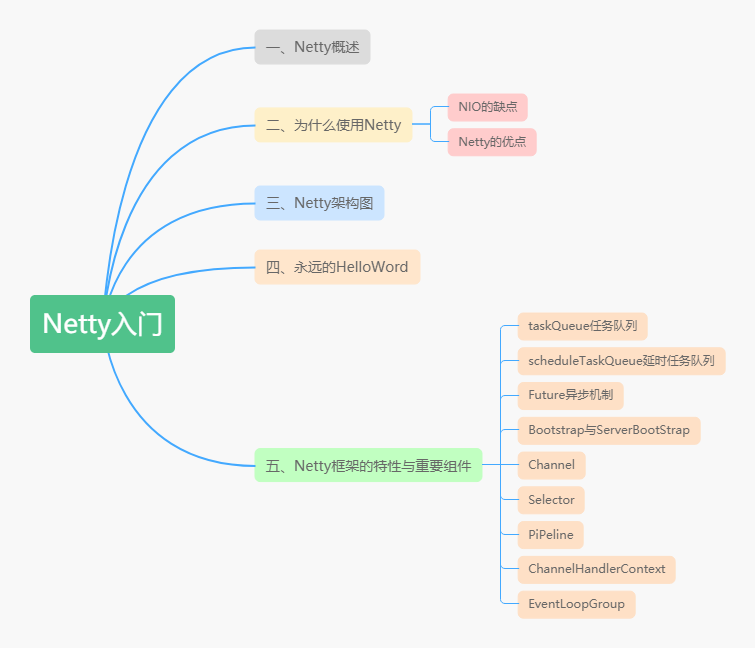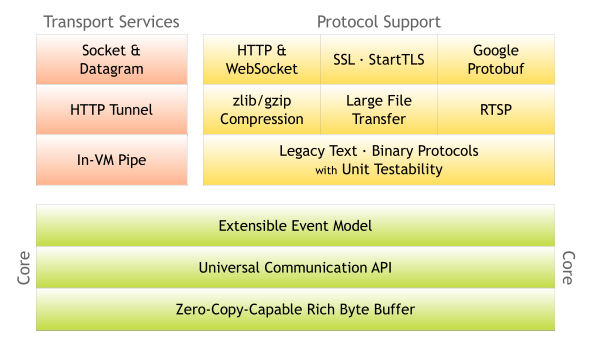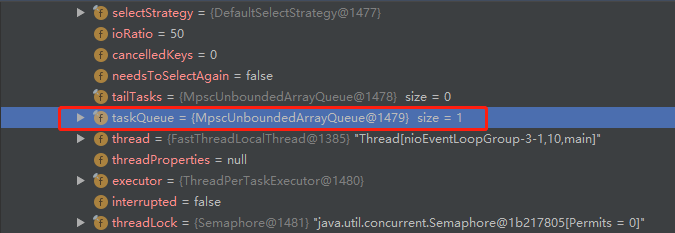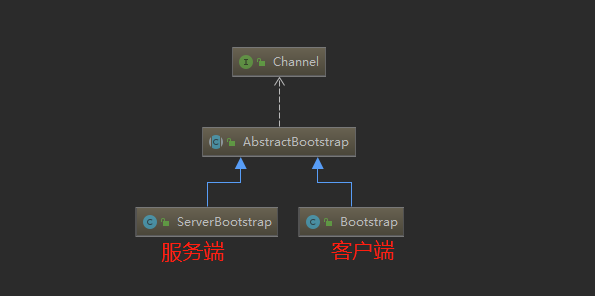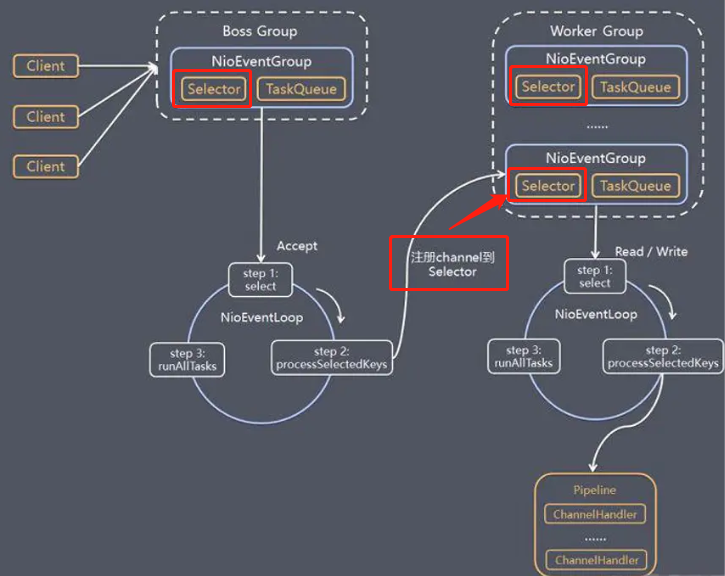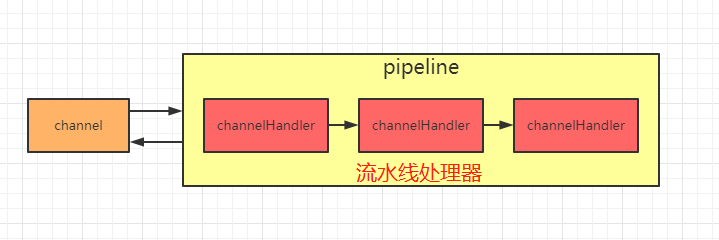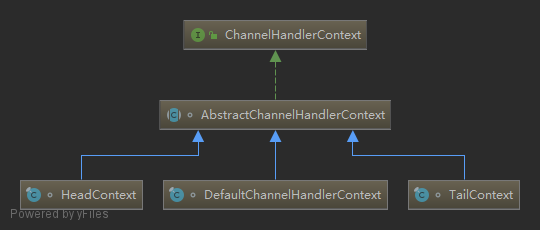本文由 简悦 SimpRead 转码, 原文地址 developer.aliyun.com
本文主要讲述 Netty 框架的一些特性以及重要组件,希望看完之后能对 Netty 框架有一个比较直观的感受,希望能帮助读者快速入门 Netty,减少一些弯路。

本文主要讲述 Netty 框架的一些特性以及重要组件,希望看完之后能对 Netty 框架有一个比较直观的感受,希望能帮助读者快速入门 Netty,减少一些弯路。
官方的介绍:
Netty is an asynchronous event-driven network application framework
for rapid development of maintainable high performance protocol servers & clients.
Netty 是 一个异步事件驱动的网络应用程序框架,用于快速开发可维护的高性能协议服务器和客户端。
从官网上介绍,Netty 是一个网络应用程序框架,开发服务器和客户端。也就是用于网络编程的一个框架。既然是网络编程,Socket 就不谈了,为什么不用 NIO 呢?
2.1 NIO 的缺点
对于这个问题,之前我写了一篇文章《NIO 入门》对 NIO 有比较详细的介绍,NIO 的主要问题是:
- NIO 的类库和 API 繁杂,学习成本高,你需要熟练掌握 Selector、ServerSocketChannel、SocketChannel、ByteBuffer 等。
- 需要熟悉 Java 多线程编程。这是因为 NIO 编程涉及到 Reactor 模式,你必须对多线程和网络编程非常熟悉,才能写出高质量的 NIO 程序。
- 臭名昭著的 epoll bug。它会导致 Selector 空轮询,最终导致 CPU 100%。直到 JDK1.7 版本依然没得到根本性的解决。
2.2 Netty 的优点
相对地,Netty 的优点有很多:
- API 使用简单,学习成本低。
- 功能强大,内置了多种解码编码器,支持多种协议。
- 性能高,对比其他主流的 NIO 框架,Netty 的性能最优。
- 社区活跃,发现 BUG 会及时修复,迭代版本周期短,不断加入新的功能。
- Dubbo、Elasticsearch 都采用了 Netty,质量得到验证。

上面这张图就是在官网首页的架构图,我们从上到下分析一下。
绿色的部分 Core 核心模块,包括零拷贝、API 库、可扩展的事件模型。
橙色部分 Protocol Support 协议支持,包括 Http 协议、webSocket、SSL(安全套接字协议)、谷歌 Protobuf 协议、zlib/gzip 压缩与解压缩、Large File Transfer 大文件传输等等。
红色的部分 Transport Services 传输服务,包括 Socket、Datagram、Http Tunnel 等等。
以上可看出 Netty 的功能、协议、传输方式都比较全,比较强大。
首先搭建一个 HelloWord 工程,先熟悉一下 API,还有为后面的学习做铺垫。以下面这张图为依据:

4.1 引入 Maven 依赖
使用的版本是 4.1.20,相对比较稳定的一个版本。
1
2
3
4
5
|
<dependency>
<groupId>io.netty</groupId>
<artifactId>netty-all</artifactId>
<version>4.1.20.Final</version>
</dependency>
|
4.2 创建服务端启动类
1
2
3
4
5
6
7
8
9
10
11
12
13
14
15
16
17
18
19
20
21
22
23
24
25
26
27
28
29
30
31
32
33
34
35
|
public class MyServer {
public static void main(String[] args) throws Exception {
//创建两个线程组 boosGroup、workerGroup
EventLoopGroup bossGroup = new NioEventLoopGroup();
EventLoopGroup workerGroup = new NioEventLoopGroup();
try {
//创建服务端的启动对象,设置参数
ServerBootstrap bootstrap = new ServerBootstrap();
//设置两个线程组boosGroup和workerGroup
bootstrap.group(bossGroup, workerGroup)
//设置服务端通道实现类型
.channel(NioServerSocketChannel.class)
//设置线程队列得到连接个数
.option(ChannelOption.SO_BACKLOG, 128)
//设置保持活动连接状态
.childOption(ChannelOption.SO_KEEPALIVE, true)
//使用匿名内部类的形式初始化通道对象
.childHandler(new ChannelInitializer<SocketChannel>() {
@Override
protected void initChannel(SocketChannel socketChannel) throws Exception {
//给pipeline管道设置处理器
socketChannel.pipeline().addLast(new MyServerHandler());
}
});//给workerGroup的EventLoop对应的管道设置处理器
System.out.println("java技术爱好者的服务端已经准备就绪...");
//绑定端口号,启动服务端
ChannelFuture channelFuture = bootstrap.bind(6666).sync();
//对关闭通道进行监听
channelFuture.channel().closeFuture().sync();
} finally {
bossGroup.shutdownGracefully();
workerGroup.shutdownGracefully();
}
}
}
|
4.3 创建服务端处理器
1
2
3
4
5
6
7
8
9
10
11
12
13
14
15
16
17
18
19
20
21
22
23
24
25
|
/**
* 自定义的Handler需要继承Netty规定好的HandlerAdapter
* 才能被Netty框架所关联,有点类似SpringMVC的适配器模式
**/
public class MyServerHandler extends ChannelInboundHandlerAdapter {
@Override
public void channelRead(ChannelHandlerContext ctx, Object msg) throws Exception {
//获取客户端发送过来的消息
ByteBuf byteBuf = (ByteBuf) msg;
System.out.println("收到客户端" + ctx.channel().remoteAddress() + "发送的消息:" + byteBuf.toString(CharsetUtil.UTF_8));
}
@Override
public void channelReadComplete(ChannelHandlerContext ctx) throws Exception {
//发送消息给客户端
ctx.writeAndFlush(Unpooled.copiedBuffer("服务端已收到消息,并给你发送一个问号?", CharsetUtil.UTF_8));
}
@Override
public void exceptionCaught(ChannelHandlerContext ctx, Throwable cause) throws Exception {
//发生异常,关闭通道
ctx.close();
}
}
|
4.4 创建客户端启动类
1
2
3
4
5
6
7
8
9
10
11
12
13
14
15
16
17
18
19
20
21
22
23
24
25
26
27
28
29
30
|
public class MyClient {
public static void main(String[] args) throws Exception {
NioEventLoopGroup eventExecutors = new NioEventLoopGroup();
try {
//创建bootstrap对象,配置参数
Bootstrap bootstrap = new Bootstrap();
//设置线程组
bootstrap.group(eventExecutors)
//设置客户端的通道实现类型
.channel(NioSocketChannel.class)
//使用匿名内部类初始化通道
.handler(new ChannelInitializer<SocketChannel>() {
@Override
protected void initChannel(SocketChannel ch) throws Exception {
//添加客户端通道的处理器
ch.pipeline().addLast(new MyClientHandler());
}
});
System.out.println("客户端准备就绪,随时可以起飞~");
//连接服务端
ChannelFuture channelFuture = bootstrap.connect("127.0.0.1", 6666).sync();
//对通道关闭进行监听
channelFuture.channel().closeFuture().sync();
} finally {
//关闭线程组
eventExecutors.shutdownGracefully();
}
}
}
|
4.5 创建客户端处理器
1
2
3
4
5
6
7
8
9
10
11
12
13
14
15
|
public class MyClientHandler extends ChannelInboundHandlerAdapter {
@Override
public void channelActive(ChannelHandlerContext ctx) throws Exception {
//发送消息到服务端
ctx.writeAndFlush(Unpooled.copiedBuffer("歪比巴卜~茉莉~Are you good~马来西亚~", CharsetUtil.UTF_8));
}
@Override
public void channelRead(ChannelHandlerContext ctx, Object msg) throws Exception {
//接收服务端发送过来的消息
ByteBuf byteBuf = (ByteBuf) msg;
System.out.println("收到服务端" + ctx.channel().remoteAddress() + "的消息:" + byteBuf.toString(CharsetUtil.UTF_8));
}
}
|
4.6 测试
先启动服务端,再启动客户端,就可以看到结果:
MyServer 打印结果:

MyClient 打印结果:

5.1 taskQueue 任务队列
如果 Handler 处理器有一些长时间的业务处理,可以交给 taskQueue 异步处理。怎么用呢,请看代码演示:
1
2
3
4
5
6
7
8
9
10
11
12
13
14
15
16
17
18
19
|
public class MyServerHandler extends ChannelInboundHandlerAdapter {
@Override
public void channelRead(ChannelHandlerContext ctx, Object msg) throws Exception {
//获取到线程池eventLoop,添加线程,执行
ctx.channel().eventLoop().execute(new Runnable() {
@Override
public void run() {
try {
//长时间操作,不至于长时间的业务操作导致Handler阻塞
Thread.sleep(1000);
System.out.println("长时间的业务处理");
} catch (Exception e) {
e.printStackTrace();
}
}
});
}
}
|
我们打一个 debug 调试,是可以看到添加进去的 taskQueue 有一个任务。

5.2 scheduleTaskQueue 延时任务队列
延时任务队列和上面介绍的任务队列非常相似,只是多了一个可延迟一定时间再执行的设置,请看代码演示:
1
2
3
4
5
6
7
8
9
10
11
12
|
ctx.channel().eventLoop().schedule(new Runnable() {
@Override
public void run() {
try {
//长时间操作,不至于长时间的业务操作导致Handler阻塞
Thread.sleep(1000);
System.out.println("长时间的业务处理");
} catch (Exception e) {
e.printStackTrace();
}
}
},5, TimeUnit.SECONDS);//5秒后执行
|
依然打开 debug 进行调试查看,我们可以有一个 scheduleTaskQueue 任务待执行中
5.3 Future 异步机制
在搭建 HelloWord 工程的时候,我们看到有一行这样的代码:
1
|
ChannelFuture channelFuture = bootstrap.connect("127.0.0.1", 6666);
|
很多操作都返回这个 ChannelFuture 对象,究竟这个 ChannelFuture 对象是用来做什么的呢?
ChannelFuture 提供操作完成时一种异步通知的方式。一般在 Socket 编程中,等待响应结果都是同步阻塞的,而 Netty 则不会造成阻塞,因为 ChannelFuture 是采取类似观察者模式的形式进行获取结果。请看一段代码演示:
1
2
3
4
5
6
7
8
9
10
11
12
13
14
|
//添加监听器
channelFuture.addListener(new ChannelFutureListener() {
//使用匿名内部类,ChannelFutureListener接口
//重写operationComplete方法
@Override
public void operationComplete(ChannelFuture future) throws Exception {
//判断是否操作成功
if (future.isSuccess()) {
System.out.println("连接成功");
} else {
System.out.println("连接失败");
}
}
});
|
5.4 Bootstrap 与 ServerBootStrap
Bootstrap 和 ServerBootStrap 是 Netty 提供的一个创建客户端和服务端启动器的工厂类,使用这个工厂类非常便利地创建启动类,根据上面的一些例子,其实也看得出来能大大地减少了开发的难度。首先看一个类图:

可以看出都是继承于 AbstractBootStrap 抽象类,所以大致上的配置方法都相同。
一般来说,使用 Bootstrap 创建启动器的步骤可分为以下几步:

5.4.1 group()
在上一篇文章《Reactor 模式》中,我们就讲过服务端要使用两个线程组:
- bossGroup 用于监听客户端连接,专门负责与客户端创建连接,并把连接注册到 workerGroup 的 Selector 中。
- workerGroup 用于处理每一个连接发生的读写事件。
一般创建线程组直接使用以下 new 就完事了:
1
2
|
EventLoopGroup bossGroup = new NioEventLoopGroup();
EventLoopGroup workerGroup = new NioEventLoopGroup();
|
有点好奇的是,既然是线程组,那线程数默认是多少呢?深入源码:
1
2
3
4
5
6
7
8
9
10
11
12
13
14
15
16
17
|
//使用一个常量保存
private static final int DEFAULT_EVENT_LOOP_THREADS;
static {
//NettyRuntime.availableProcessors() * 2,cpu核数的两倍赋值给常量
DEFAULT_EVENT_LOOP_THREADS = Math.max(1, SystemPropertyUtil.getInt(
"io.netty.eventLoopThreads", NettyRuntime.availableProcessors() * 2));
if (logger.isDebugEnabled()) {
logger.debug("-Dio.netty.eventLoopThreads: {}", DEFAULT_EVENT_LOOP_THREADS);
}
}
protected MultithreadEventLoopGroup(int nThreads, Executor executor, Object... args) {
//如果不传入,则使用常量的值,也就是cpu核数的两倍
super(nThreads == 0 ? DEFAULT_EVENT_LOOP_THREADS : nThreads, executor, args);
}
|
通过源码可以看到,默认的线程数是 cpu 核数的两倍。假设想自定义线程数,可以使用有参构造器:
1
2
3
4
|
//设置bossGroup线程数为1
EventLoopGroup bossGroup = new NioEventLoopGroup(1);
//设置workerGroup线程数为16
EventLoopGroup workerGroup = new NioEventLoopGroup(16);
|
5.4.2 channel()
这个方法用于设置通道类型,当建立连接后,会根据这个设置创建对应的 Channel 实例。
使用 debug 模式可以看到
通道类型有以下:
NioSocketChannel: 异步非阻塞的客户端 TCP Socket 连接。
NioServerSocketChannel: 异步非阻塞的服务器端 TCP Socket 连接。
常用的就是这两个通道类型,因为是异步非阻塞的。所以是首选。
OioSocketChannel: 同步阻塞的客户端 TCP Socket 连接。
OioServerSocketChannel: 同步阻塞的服务器端 TCP Socket 连接。
稍微在本地调试过,用起来和 Nio 有一些不同,是阻塞的,所以 API 调用也不一样。因为是阻塞的 IO,几乎没什么人会选择使用 Oio,所以也很难找到例子。我稍微琢磨了一下,经过几次报错之后,总算调通了。代码如下:
1
2
3
4
5
6
7
8
9
10
11
12
13
|
//server端代码,跟上面几乎一样,只需改三个地方
//这个地方使用的是OioEventLoopGroup
EventLoopGroup bossGroup = new OioEventLoopGroup();
ServerBootstrap bootstrap = new ServerBootstrap();
bootstrap.group(bossGroup)//只需要设置一个线程组boosGroup
.channel(OioServerSocketChannel.class)//设置服务端通道实现类型
//client端代码,只需改两个地方
//使用的是OioEventLoopGroup
EventLoopGroup eventExecutors = new OioEventLoopGroup();
//通道类型设置为OioSocketChannel
bootstrap.group(eventExecutors)//设置线程组
.channel(OioSocketChannel.class)//设置客户端的通道实现类型
|
NioSctpChannel: 异步的客户端 Sctp(Stream Control Transmission Protocol,流控制传输协议)连接。
NioSctpServerChannel: 异步的 Sctp 服务器端连接。
本地没启动成功,网上看了一些网友的评论,说是只能在 linux 环境下才可以启动。从报错信息看:SCTP not supported on this platform,不支持这个平台。因为我电脑是 window 系统,所以网友说的有点道理。
5.4.3 option() 与 childOption()
首先说一下这两个的区别。
option() 设置的是服务端用于接收进来的连接,也就是 boosGroup 线程。
childOption() 是提供给父管道接收到的连接,也就是 workerGroup 线程。
搞清楚了之后,我们看一下常用的一些设置有哪些:
SocketChannel 参数,也就是 childOption() 常用的参数:
SO_RCVBUF Socket 参数,TCP 数据接收缓冲区大小。
TCP_NODELAY TCP 参数,立即发送数据,默认值为 Ture。
SO_KEEPALIVE Socket 参数,连接保活,默认值为 False。启用该功能时,TCP 会主动探测空闲连接的有效性。
ServerSocketChannel 参数,也就是 option() 常用参数:
SO_BACKLOG Socket 参数,服务端接受连接的队列长度,如果队列已满,客户端连接将被拒绝。默认值,Windows 为 200,其他为 128。
由于篇幅限制,其他就不列举了,大家可以去网上找资料看看,了解一下。
5.4.4 设置流水线 (重点)
ChannelPipeline 是 Netty 处理请求的责任链,ChannelHandler 则是具体处理请求的处理器。实际上每一个 channel 都有一个处理器的流水线。
在 Bootstrap 中 childHandler() 方法需要初始化通道,实例化一个 ChannelInitializer,这时候需要重写 initChannel() 初始化通道的方法,装配流水线就是在这个地方进行。代码演示如下:
1
2
3
4
5
6
7
8
|
//使用匿名内部类的形式初始化通道对象
bootstrap.childHandler(new ChannelInitializer<SocketChannel>() {
@Override
protected void initChannel(SocketChannel socketChannel) throws Exception {
//给pipeline管道设置自定义的处理器
socketChannel.pipeline().addLast(new MyServerHandler());
}
});
|
处理器 Handler 主要分为两种:
ChannelInboundHandlerAdapter(入站处理器)、ChannelOutboundHandler(出站处理器)
入站指的是数据从底层 java NIO Channel 到 Netty 的 Channel。
出站指的是通过 Netty 的 Channel 来操作底层的 java NIO Channel。
ChannelInboundHandlerAdapter 处理器常用的事件有:
- 注册事件 fireChannelRegistered。
- 连接建立事件 fireChannelActive。
- 读事件和读完成事件 fireChannelRead、fireChannelReadComplete。
- 异常通知事件 fireExceptionCaught。
- 用户自定义事件 fireUserEventTriggered。
- Channel 可写状态变化事件 fireChannelWritabilityChanged。
- 连接关闭事件 fireChannelInactive。
ChannelOutboundHandler 处理器常用的事件有:
- 端口绑定 bind。
- 连接服务端 connect。
- 写事件 write。
- 刷新时间 flush。
- 读事件 read。
- 主动断开连接 disconnect。
- 关闭 channel 事件 close。
还有一个类似的 handler(),主要用于装配 parent 通道,也就是 bossGroup 线程。一般情况下,都用不上这个方法。
5.4.5 bind()
提供用于服务端或者客户端绑定服务器地址和端口号,默认是异步启动。如果加上 sync() 方法则是同步。
有五个同名的重载方法,作用都是用于绑定地址端口号。不一一介绍了。
5.4.6 优雅地关闭 EventLoopGroup
1
2
3
|
//释放掉所有的资源,包括创建的线程
bossGroup.shutdownGracefully();
workerGroup.shutdownGracefully();
|
会关闭所有的 child Channel。关闭之后,释放掉底层的资源。
5.5 Channel
Channel 是什么?不妨看一下官方文档的说明:
A nexus to a network socket or a component which is capable of I/O operations such as read, write, connect, and bind
翻译大意:一种连接到网络套接字或能进行读、写、连接和绑定等 I/O 操作的组件。
如果上面这段说明比较抽象,下面还有一段说明:
A channel provides a user:
the current state of the channel (e.g. is it open? is it connected?),
the configuration parameters of the channel (e.g. receive buffer size),
the I/O operations that the channel supports (e.g. read, write, connect, and bind), and
the ChannelPipeline which handles all I/O events and requests associated with the channel.
翻译大意:
channel 为用户提供:
- 通道当前的状态(例如它是打开?还是已连接?)
- channel 的配置参数(例如接收缓冲区的大小)
- channel 支持的 IO 操作(例如读、写、连接和绑定),以及处理与 channel 相关联的所有 IO 事件和请求的 ChannelPipeline。
5.5.1 获取 channel 的状态
1
2
3
4
|
boolean isOpen(); //如果通道打开,则返回true
boolean isRegistered();//如果通道注册到EventLoop,则返回true
boolean isActive();//如果通道处于活动状态并且已连接,则返回true
boolean isWritable();//当且仅当I/O线程将立即执行请求的写入操作时,返回true。
|
以上就是获取 channel 的四种状态的方法。
5.5.2 获取 channel 的配置参数
获取单条配置信息,使用 getOption(),代码演示:
1
2
3
4
|
ChannelConfig config = channel.config();//获取配置参数
//获取ChannelOption.SO_BACKLOG参数,
Integer soBackLogConfig = config.getOption(ChannelOption.SO_BACKLOG);
//因为我启动器配置的是128,所以我这里获取的soBackLogConfig=128
|
获取多条配置信息,使用 getOptions(),代码演示:
1
2
3
4
5
6
7
8
9
10
11
12
|
ChannelConfig config = channel.config();
Map<ChannelOption<?>, Object> options = config.getOptions();
for (Map.Entry<ChannelOption<?>, Object> entry : options.entrySet()) {
System.out.println(entry.getKey() + " : " + entry.getValue());
}
/**
SO_REUSEADDR : false
WRITE_BUFFER_LOW_WATER_MARK : 32768
WRITE_BUFFER_WATER_MARK : WriteBufferWaterMark(low: 32768, high: 65536)
SO_BACKLOG : 128
以下省略...
*/
|
5.5.3 channel 支持的 IO 操作
写操作,这里演示从服务端写消息发送到客户端:
1
2
3
4
|
@Override
public void channelRead(ChannelHandlerContext ctx, Object msg) throws Exception {
ctx.channel().writeAndFlush(Unpooled.copiedBuffer("这波啊,这波是肉蛋葱鸡~", CharsetUtil.UTF_8));
}
|
客户端控制台:
1
|
//收到服务端/127.0.0.1:6666的消息:这波啊,这波是肉蛋葱鸡~
|
连接操作,代码演示:
1
|
ChannelFuture connect = channelFuture.channel().connect(new InetSocketAddress("127.0.0.1", 6666));//一般使用启动器,这种方式不常用
|
通过 channel 获取 ChannelPipeline,并做相关的处理:
1
2
3
4
|
//获取ChannelPipeline对象
ChannelPipeline pipeline = ctx.channel().pipeline();
//往pipeline中添加ChannelHandler处理器,装配流水线
pipeline.addLast(new MyServerHandler());
|
5.6 Selector
在 NioEventLoop 中,有一个成员变量 selector,这是 nio 包的 Selector,在之前《NIO 入门》中,我已经讲过 Selector 了。
Netty 中的 Selector 也和 NIO 的 Selector 是一样的,就是用于监听事件,管理注册到 Selector 中的 channel,实现多路复用器。

5.7 PiPeline 与 ChannelPipeline
在前面介绍 Channel 时,我们知道可以在 channel 中装配 ChannelHandler 流水线处理器,那一个 channel 不可能只有一个 channelHandler 处理器,肯定是有很多的,既然是很多 channelHandler 在一个流水线工作,肯定是有顺序的。
于是 pipeline 就出现了,pipeline 相当于处理器的容器。初始化 channel 时,把 channelHandler 按顺序装在 pipeline 中,就可以实现按序执行 channelHandler 了。

在一个 Channel 中,只有一个 ChannelPipeline。该 pipeline 在 Channel 被创建的时候创建。ChannelPipeline 包含了一个 ChannelHander 形成的列表,且所有 ChannelHandler 都会注册到 ChannelPipeline 中。
5.8 ChannelHandlerContext
在 Netty 中,Handler 处理器是有我们定义的,上面讲过通过集成入站处理器或者出站处理器实现。这时如果我们想在 Handler 中获取 pipeline 对象,或者 channel 对象,怎么获取呢。
于是 Netty 设计了这个 ChannelHandlerContext 上下文对象,就可以拿到 channel、pipeline 等对象,就可以进行读写等操作。

通过类图,ChannelHandlerContext 是一个接口,下面有三个实现类。
实际上 ChannelHandlerContext 在 pipeline 中是一个链表的形式。看一段源码就明白了:
1
2
3
4
5
6
7
8
9
10
11
12
|
//ChannelPipeline实现类DefaultChannelPipeline的构造器方法
protected DefaultChannelPipeline(Channel channel) {
this.channel = ObjectUtil.checkNotNull(channel, "channel");
succeededFuture = new SucceededChannelFuture(channel, null);
voidPromise = new VoidChannelPromise(channel, true);
//设置头结点head,尾结点tail
tail = new TailContext(this);
head = new HeadContext(this);
head.next = tail;
tail.prev = head;
}
|
下面我用一张图来表示,会更加清晰一点:

5.9 EventLoopGroup
我们先看一下 EventLoopGroup 的类图:

其中包括了常用的实现类 NioEventLoopGroup。OioEventLoopGroup 在前面的例子中也有使用过。
从 Netty 的架构图中,可以知道服务器是需要两个线程组进行配合工作的,而这个线程组的接口就是 EventLoopGroup。
每个 EventLoopGroup 里包括一个或多个 EventLoop,每个 EventLoop 中维护一个 Selector 实例。
5.9.1 轮询机制的实现原理
我们不妨看一段 DefaultEventExecutorChooserFactory 的源码:
1
2
3
4
5
6
7
8
|
private final AtomicInteger idx = new AtomicInteger();
private final EventExecutor[] executors;
@Override
public EventExecutor next() {
//idx.getAndIncrement()相当于idx++,然后对任务长度取模
return executors[idx.getAndIncrement() & executors.length - 1];
}
|
这段代码可以确定执行的方式是轮询机制,接下来 debug 调试一下:
它这里还有一个判断,如果线程数不是 2 的 N 次方,则采用取模算法实现。
1
2
3
4
|
@Override
public EventExecutor next() {
return executors[Math.abs(idx.getAndIncrement() % executors.length)];
}
|
参考 Netty 官网文档:API 文档
